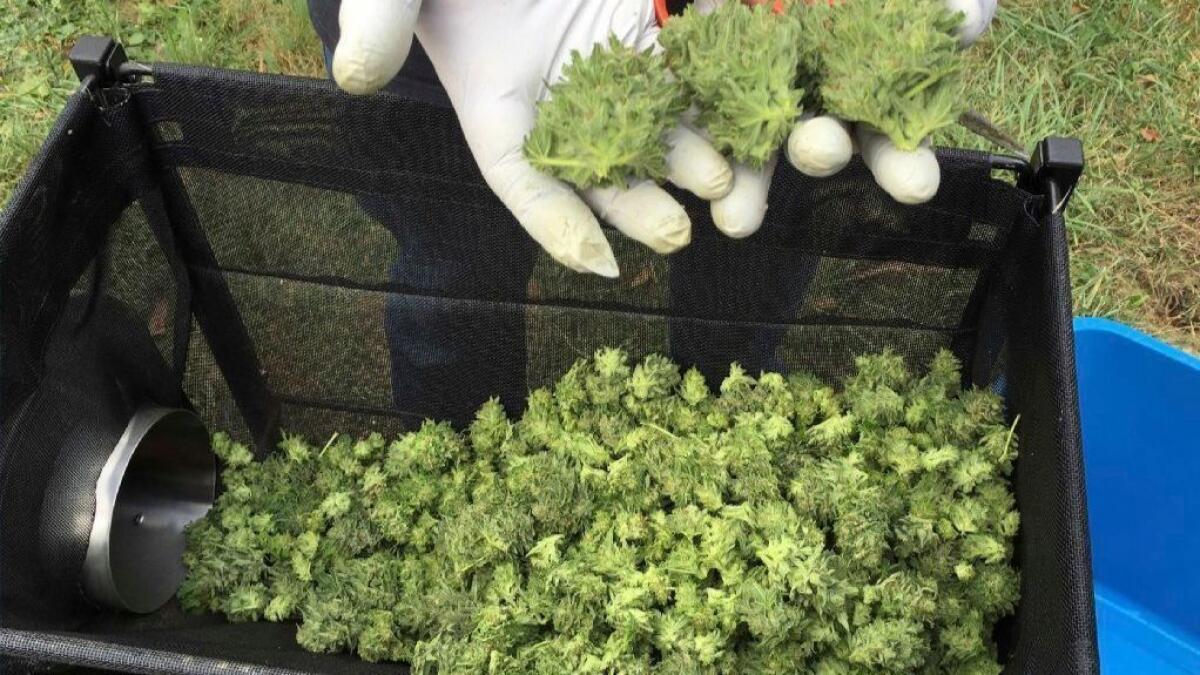Oregon has too much cannabis. Two laws may help the state manage its surplus

Matt Millerâs family has farmed pot in Oregon since well before it became legal.
But since the market flooded after recreational use was approved by state voters in 2014, prices have plummeted, putting strain on the operation he runs with his wife, Rhea.
Oregonâs lush climate and weed-tolerant culture have long resulted in large and potent harvests. Seeking to fold black market growers into its budding legal industry, the state has distributed licenses liberally, leaving Oregon saddled with an enormous surplus of legal cannabis â more than its small population of 4 million would ever be able to smoke.
Now, Oregon lawmakers are hoping to tackle the problem, with two bills signed into law in the past week: one aimed at curbing excess production and the other seeking to establish new markets to funnel excess weed into.
Senate Bill 218 gives the Oregon Liquor Control Commission more power over issuing new licenses based on an assessment of supply-and-demand conditions. SB 582 aims to lay the groundwork to eventually divert the stateâs oversaturated marijuana market by giving the governor the green light to enter into agreements with other states for cannabis imports and exports.
It is illegal to transport cannabis to other states, and so the export legislation hinges on action in Washington, D.C., in the form of a change in federal law or guidance issued by the U.S. Department of Justice allowing or tolerating interstate transfers.
The Trump administration has been unfriendly to legal weed. Last year, then-Atty. Gen Jeff Sessions rescinded an Obama-era federal policy called the Cole memorandum, which allowed states to legalize pot without the threat of a federal crackdown. Sessionsâ replacement, William Barr, confirmed to U.S. senators in January that he would not push for this crackdown (which never materialized under Sessions). But his hands-off approach to legal weed does not by any means signal that the administration will allow trade between states.
Adam J. Smith, founder and director of the Craft Cannabis Alliance, based in Oregon â which helped push for the export bill â is optimistic that a change at the federal level is around the corner, particularly if a Democrat defeats Trump in 2020.
It just doesnât make sense, he said, that states legalizing weed are forced to create their own self-contained industry.
âYou have people using water in the desert in Nevada to grow mediocre cannabis, or in Florida, where they have to dehumidify giant spaces, consuming twice the energy,â Smith said. âOregon wouldnât have an oversupply problem if we could access legal markets like these.â
West Hollywoodâs original marijuana dispensaries fear city will leave them behind Âť
Recreational marijuana is legal in 11 states; medical marijuana is legal in 33.
Smith and other advocates are exploring the idea of pushing a similar bill â giving officials authority to enter into marijuana trade agreements with other states â through the Legislature in California. The end goal is to move cannabis between states by 2021.
Unlike other states that have legalized recreational marijuana, including California, Washington and Colorado, Oregon did not implement tight restrictions on the number of cannabis licenses. (Some of these states also have a glut of marijuana. However, a smaller proportion of the supply is legal and on the books, and their populations are larger so the supply-to-demand dynamic isnât as stark as Oregonâs.)
Oregon recognized that for generations cannabis culture had been part of its fabric and decided to allow the black market growers into the legal market, according to Andrew Livingston, director of economics and research at Vicente Sederberg, a Denver-based law firm that provides legal and policy services to cannabis businesses.
âThey put out advertisements, they did a whole âgo legalâ campaign to attract Oregon cannabis growers to the legal market, and it worked. People jumped on board,â Livingston said. âThey wanted to make it as easy as possible to make those businesses become legal and licensed.â
The result was about 2,100 grower licensees as of January, and enough weed that it would take an estimated 6.5 years to sell it all within Oregon without any more production, according to a 2019 Oregon Liquor Control Commission report.
If that were the case, much of the supply would actually go stale, since it has a shelf life of maybe four to eight months if sealed and kept out of the light, Livingston said. As a result, many producers are turning their supplies of weed into extracted oil, which lasts a bit longer â over a year.
The median price of weed in Oregon fell steadily over two years, from more than $10 per gram in October 2016 to less than $5 in December 2018.
Because the market was flooded, the Millers grew in only half of their 40,000 square feet of permitted space last year, and at the same time, the price of the flower has dropped precipitously.
âThose two things really hit us fast and hard,â Matt Miller said. âIt was pretty scary and intimidating.â
Legal weed can raise the roof on home prices Âť
Giving the commission more leeway to stanch the flow of new licenses is a practical move on the stateâs part, Livingston said. But the law is likely to have limited impact since the state already placed a moratorium on processing new licenses a year ago.
A January audit by the Oregon secretary of stateâs office found Oregonâs regulatory systems were weak and lacking in adequate inspections.
Oregon and California historically have been the two leading producers of marijuana in the nation â and growers in both states illegally export large quantities (though itâs difficult to quantify exactly how much), said Hezekiah Allen, a cannabis lobbyist and former head of the California Growers Assn.
California, like Oregon, struggles with an oversupply of cannabis. Though Oregon became the first state to decriminalize marijuana possession in 1973, the state did not create a medical marijuana program until 1998, two years after California.
Vessel Logistics, a San Francisco-based cannabis distribution company, said in a report that the cannabis industry in California had over-relied on the black market and out-of-state sales, causing producers to overestimate the stateâs actual demand, according to the Sacramento Bee.
Black market cannabis shops thrive in L.A. even as city cracks down Âť
In California, a patchwork of rules governs individual jurisdictions. About 75% of municipalities donât allow retail sales â and those probably have illegal operators who have been selling for years. Californiaâs Bureau of Cannabis Control has sent about 3,500 cease-and-desist orders to illegal retailers since January 2018.
Californiaâs surplus is worsened by the fact that the state has limited licensed retail stores â people arenât buying cannabis from licensed retailers, Allen said.
âWe donât have enough places to sell the stuff, so thatâs a big problem,â he said. âFolks everywhere in the country are consuming cannabis, and very few states produce significant amounts.â
He pointed out Oregonâs legislation would not be helpful for trade with nearby states that also have an oversupply. California has too much; so does Washington, another early legalizer.
âItâs awesome Oregon is trying to do something,â Allen said, âbut the real solution really will come at the federal level.â
More to Read
Sign up for Essential California
The most important California stories and recommendations in your inbox every morning.
You may occasionally receive promotional content from the Los Angeles Times.











